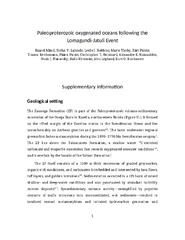| dc.contributor.author | Mänd, Kaarel | |
| dc.contributor.author | Lalonde, Stefan V. | |
| dc.contributor.author | Robbins, Leslie J. | |
| dc.contributor.author | Thoby, Marie | |
| dc.contributor.author | Paiste, Kärt | |
| dc.contributor.author | Kreitsmann, Timmu | |
| dc.contributor.author | Paiste, Päärn | |
| dc.contributor.author | Reinhard, Christopher T. | |
| dc.contributor.author | Romashkin, Alexandr E. | |
| dc.contributor.author | Planavsky, Noah J. | |
| dc.contributor.author | Kirsimäe, Kalle | |
| dc.contributor.author | Lepland, Aivo | |
| dc.contributor.author | Konhauser, Kurt O. | |
| dc.date.accessioned | 2020-09-09T08:59:13Z | |
| dc.date.available | 2020-09-09T08:59:13Z | |
| dc.date.issued | 2020-03-16 | |
| dc.description.abstract | The approximately 2,220–2,060 million years old Lomagundi–Jatuli Event was the longest positive carbon isotope excursion in Earth history and is traditionally interpreted to reflect an increased organic carbon burial and a transient rise in atmospheric O<sub>2</sub>. However, it is widely held that O<sub>2</sub> levels collapsed for more than a billion years after this. Here we show that black shales postdating the Lomagundi–Jatuli Event from the approximately 2,000 million years old Zaonega Formation contain the highest redox-sensitive trace metal concentrations reported in sediments deposited before the Neoproterozoic (maximum concentrations of Mo = 1,009 μg g<sup>−1</sup>, U = 238 μg g<sup>−1</sup> and Re = 516 ng g<sup>−1</sup>). This unit also contains the most positive Precambrian shale U isotope values measured to date (maximum <sup>238</sup>U/<sup>235</sup>U ratio of 0.79‰), which provides novel evidence that there was a transition to modern-like biogeochemical cycling during the Palaeoproterozoic. Although these records do not preclude a return to anoxia during the Palaeoproterozoic, they uniquely suggest that the oceans remained well-oxygenated millions of years after the termination of the Lomagundi–Jatuli Event. | en_US |
| dc.identifier.citation | Mänd K, Lalonde, Robbins, Thoby, Paiste K, Kreitsmann T, Paiste P, Reinhard, Romashkin, Planavsky, Kirsimäe K, Lepland A, Konhauser KO. Palaeoproterozoic oxygenated oceans following the Lomagundi–Jatuli Event. Nature Geoscience. 2020;13(4):302-306 | en_US |
| dc.identifier.cristinID | FRIDAID 1806050 | |
| dc.identifier.doi | 10.1038/s41561-020-0558-5 | |
| dc.identifier.issn | 1752-0894 | |
| dc.identifier.issn | 1752-0908 | |
| dc.identifier.uri | https://hdl.handle.net/10037/19269 | |
| dc.language.iso | eng | en_US |
| dc.publisher | Springer Nature | en_US |
| dc.relation.journal | Nature Geoscience | |
| dc.relation.projectID | info:eu-repo/grantAgreement/RCN/SFF/223259/Norway/Centre for Arctic Gas Hydrate, Environment and Climate/CAGE/ | en_US |
| dc.rights.accessRights | openAccess | en_US |
| dc.rights.holder | Copyright 2020 Springer Nature | en_US |
| dc.subject | VDP::Mathematics and natural science: 400::Geosciences: 450::Stratigraphy and paleontology: 461 | en_US |
| dc.subject | VDP::Matematikk og Naturvitenskap: 400::Geofag: 450::Stratigrafi og paleontologi: 461 | en_US |
| dc.subject | VDP::Mathematics and natural science: 400::Geosciences: 450::Mineralogy, petrology, geochemistry: 462 | en_US |
| dc.subject | VDP::Matematikk og Naturvitenskap: 400::Geofag: 450::Mineralogi, petrologi, geokjemi: 462 | en_US |
| dc.title | Palaeoproterozoic oxygenated oceans following the Lomagundi–Jatuli Event | en_US |
| dc.type.version | acceptedVersion | en_US |
| dc.type | Journal article | en_US |
| dc.type | Tidsskriftartikkel | en_US |
| dc.type | Peer reviewed | en_US |


 English
English norsk
norsk
